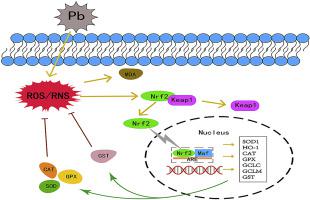Ecotoxicology and Environmental Safety ( IF 6.2 ) Pub Date : 2020-09-08 , DOI: 10.1016/j.ecoenv.2020.111231 Xianlei Jiang 1 , Xupeng Xing 1 , Yingbing Zhang 1 , Chengtu Zhang 2 , Ying Wu 2 , Yongzhong Chen 2 , Ru Meng 2 , Huiqun Jia 1 , Yuyao Cheng 1 , Yong Zhang 1 , Jianmin Su 1

|
Lead, a common metallic contaminant, is widespread in the living environment, and has deleterious effects on the reproductive systems of humans and animals. Although numerous toxic effects of lead have been reported, the effects and underlying mechanisms of the impacts of lead exposure on the female reproductive system, especially oocyte maturation and fertility, remain unknown. In this study, mice were treated by gavage for seven days to evaluate the reproductive damage and role of Nrf2-mediated defense responses during lead exposure. Lead exposure significantly reduced the maturation and fertilization of oocytes in vivo. Additionally, lead exposure triggered oxidative stress with a decreased glutathione level, increased amount of reactive oxygen species, and abnormal mitochondrial distribution. Moreover, lead exposure caused histopathological and ultrastructural changes in oocytes and ovaries, along with decreases in the activities of catalase, glutathione peroxidase, total superoxide dismutase, and glutathione-S transferase, and increases in the levels of malonaldehyde in mouse ovaries. Further experiments demonstrated that lead exposure activated the Nrf2 signaling pathway to protect oocytes against oxidative stress by enhancing the transcription levels of antioxidant enzymes. In conclusion, our study demonstrates that lead activates the Nrf2/Keap1 pathway and impairs oocyte maturation and fertilization by inducing oxidative stress, leading to a decrease in the fertility of female mice.
中文翻译:

铅暴露激活了Nrf2 / Keap1途径,加剧了氧化应激,并诱发了雌性小鼠的生殖损伤。
铅是一种常见的金属污染物,广泛存在于生活环境中,并对人类和动物的生殖系统产生有害影响。尽管已经报道了铅的多种毒性作用,但是铅暴露对女性生殖系统的影响及其潜在机制,尤其是卵母细胞的成熟和受精,仍然未知。在这项研究中,小鼠被管饲七天,以评估铅暴露期间的生殖损伤和Nrf2介导的防御反应的作用。铅暴露显着降低了体内卵母细胞的成熟和受精。此外,铅的接触会触发氧化应激,导致谷胱甘肽水平降低,活性氧含量增加以及线粒体分布异常。此外,铅暴露引起卵母细胞和卵巢的组织病理学和超微结构变化,以及过氧化氢酶,谷胱甘肽过氧化物酶,总超氧化物歧化酶和谷胱甘肽-S转移酶的活性下降,并且小鼠卵巢中丙二醛的水平增加。进一步的实验表明,铅暴露激活了Nrf2信号通路,通过增强抗氧化酶的转录水平来保护卵母细胞免受氧化应激。总之,我们的研究表明铅激活了Nrf2 / Keap1。 该途径并通过诱导氧化应激而损害卵母细胞的成熟和受精,导致雌性小鼠的生育力降低。











































 京公网安备 11010802027423号
京公网安备 11010802027423号